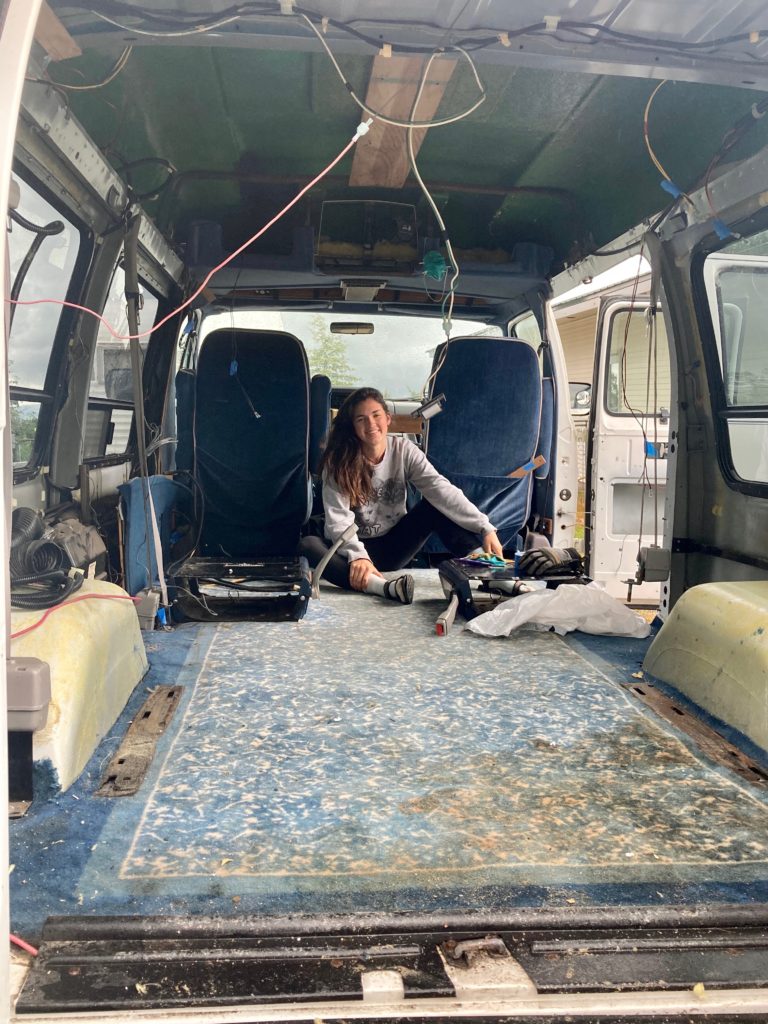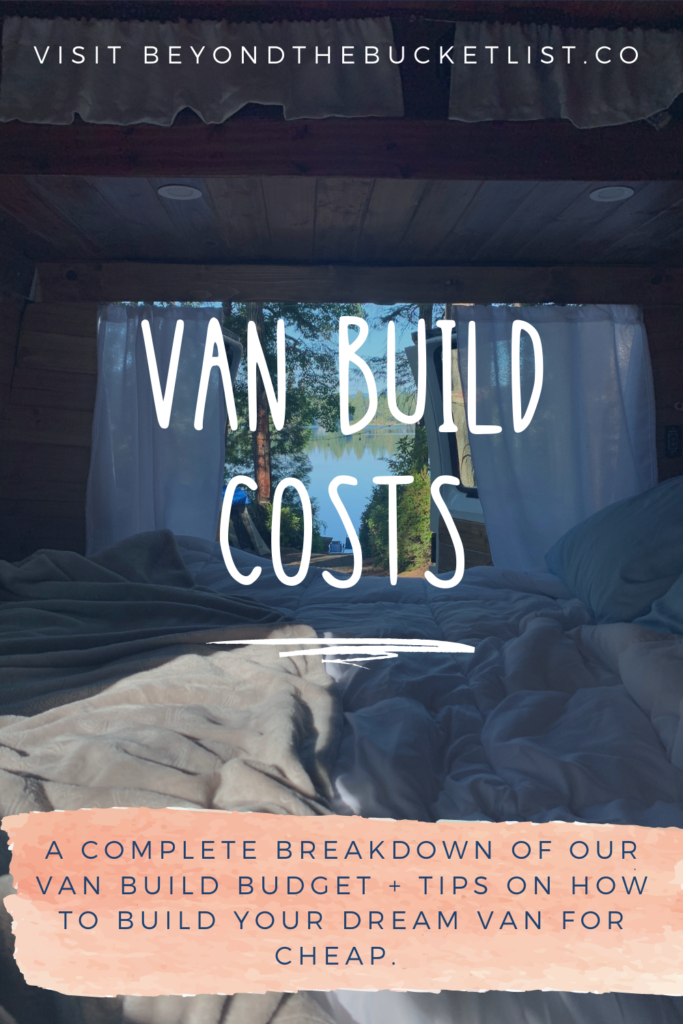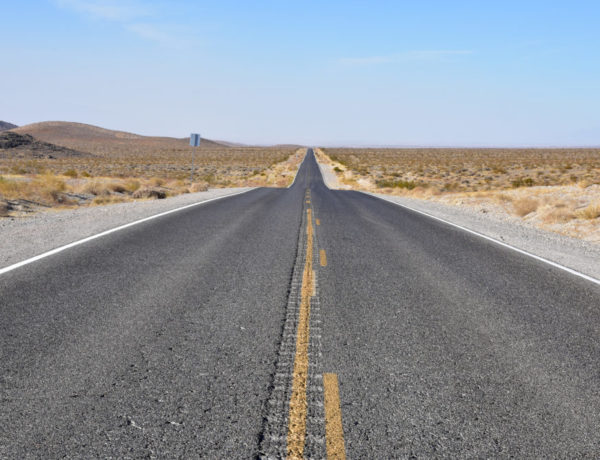This post may contain affiliate links. This just means I may receive a small commission at no extra cost to you for helping them promote their product or service. I don’t endorse any services I don’t personally use or recommend.
With Instagram flooded with photos of perfectly polished Sprinter Vans & $15,000 dollar conversions being marketed as “budget builds” it’s no wonder that many people dismiss vanlife as a bucketlist dream. But it doesn’t have to cost an arm & a leg.
We built a van. & we did it on a budget.


A converted van allows you to explore some of the most expensive travel destinations in the world on a meager backpacker’s budget. But it’s not just the freedom to travel in expensive places there are tons of reasons to give vanlife a whirl. There’s a reason New Zealand, Australia, & the United States are the most common countries for Vanlife after all.
So, exactly how much did our budget build cost?
We’ll get there. But before we dive into exactly how much our van conversion cost us, let’s take a look at some important things you should consider before you build your dream van.
Important Decisions for Your Build.
These 5 decisions have the greatest impact on your van build costs. No van conversion is exactly the same and every builder is different. You might require different amenities on the road than others. After all, there’s no right way to build a van. You just want to be in love with the end result.
Are you Full-Time or Part-Time?
This might be the most crucial question. If you plan to live in your rig full-time there are things you may not want to skimp on. While you may be okay with an outdoor shower system for a couple of weeks on your summer road trip, things change if this van is your year-round home and December rolls around.
This is a preliminary question. Before you make any decisions on the 5 questions decide what your longest trip is likely to be. A week? A month? Years? & decide from there what you’re “Must-Have’s” are.
Which Van type is right for you?
Conversion Van? Sprinter? Ford Transit? Vanagon? Westie? Promaster? School Bus? Ambulance? Truck-Bed Camper? There are WAY more options out there than you think. & they all vary in upfront cost, maintenance cost, lifespan, & height.
As budget builders, we wanted a decent lifespan on a vehicle that was cheap upfront & had low-maintenance costs. So we sacrificed a little height.
Where to Look for Budget-Friendly Vans? Craigslist & Facebook Marketplace. Listings go up every single day and we must have looked at 20 vans before we found the perfect one. I do recommend when buying from a private seller to always have it checked out by a mechanic of your choice before you buy. {Which typically costs around $100}
What Kind of Insulation Will You Use?
You don’t HAVE to insulate your van. (But we strongly recommend it) & there are tons of options. From the eco-friendly {& pricey} Havelock Sheeps Wool to Poly-Iso Boards you’ll have to make lots of insulation decisions. Like will you insulate the floor?
Personally, I think that the best bang for your buck comes in the form of Poly-Iso boards. But you’ll likely need a combination of insulation types for the whole build.

What Kind of Electrical System Do You Need?
Solar, Shore-Power, or off-the-grid deep cycle batteries? Do you even require electricity at all?
If you plan on using the van for short weekend jaunts then maybe you can skip this altogether.
What is in Your Kitchenette Area?
A fridge? Sink? Propane stove unit? I’ve seen some vans even have an oven. You can get real basic or real fancy here. & it’s one of the easiest ways to save money on your build.
If you’re any kind of camper you know that with a single propane burner and a pan you can cook loads of meals without having to worry about installing fancy kitchen equipment.
How About that Shower {+ bathroom} Situation?
Building a shower or toilet inside your van takes up A LOT of space. & it increases your costs exponentially. You have to make sure the room is sealed off and waterproof, put in a water system, and a drain. & that’s not even considering a toilet.
But the alternative is an outdoor shower. Some people create a rooftop solar-heated water system & others just use a shower bag unceremoniously draped from the rooftop. You can also shower at campgrounds or utilize a gym membership.
This is one of the least glamourous aspects of vanlife. Before you commit to this endeavor I highly recommend reading these two posts to be sure you can handle it. The Unglamorous Reality of Vanlife & How to Not Kill Your Significant Other While Living The Vanlife.
How Did We Answer these Questions?
Our Van Choice
1994 Dodge Ram Van. 116,000 Miles. Lots of life left, cheap to maintain, & $4,000 upfront. We opted to skip the Sprinter. & as first-time van builders, we don’t regret it.

Downside: I’m 5′ 6” & my partner Evan is 6′. Our van ceiling height is 5′ 5″. Since we aren’t living in the van full-time we figured we could handle the inconvenience of not being able to stand completely upright. We remedied this by creating a bed that turns into benches & a table to use during the day & purchased some sitting cushions for the floor so we can cook while sitting comfortably.
Insulation
We used a carefully calculated combination of several insulation methods. Here’s what we did.
- Poly-Iso Foam Boards for the walls & ceiling.
- Reflectix & Poly-Iso Foam Boards over the windows we boarded up.
- Neoprene foam strips for the floor grooves.
- Fiberglass Foam Batts for the door panels & curved portions of the ceiling.
- Gaps & Cracks Foam Filler to fill in ALL the insulation gaps in the walls & ceiling.
- Reflectix covers for the windows when parked.
Electrical
We needed it.
We chose off-the-grid deep cycle batteries. Why? Because it’s cheaper and more effective than solar. The system we built uses two deep cycle batteries & powers our fan, 4 overhead lights, refrigerator, 2 USB outlets, & 2 regular outlets with ease. It recharges as we drive off of the alternator with no risk of draining the main battery of the vehicle and leaving us stranded.
Kitchen

We went simple.
We wanted a water system with a sink & also a fridge to keep perishables {beer} cold. But we didn’t really need a built-in propane system or a built-in grill. We can use a countertop Coleman burner for our cooking needs.
Shower
We’re going to be long-term trippers, traveling for several months at a time. & yes, it’s going to be inconvenient at times, but in the end, we decided a shower wasn’t necessary.
Instead, we bought a solar-heated shower bag.
This is the shower we use & recommend for minimalists.

We never even considered a toilet. Some vanlifers love their compostable toilets but we noticed most still admitted to a little bit of a smell & in such a small space…that’s not something we’re interested in.
Sleeping Situation
There are countless ways to set up your bed. Do you want it lofted with storage underneath? Convertible for maximum utility? Or would you prefer a stationary bed?
We chose to craft a convertible bed that can be turned into U-shaped benches and a nice sturdy table for daytime use. Unfortunately, it hasn’t been the most beneficial layout for us. We discuss that more in our vanlife regrets blog post.
One of the major drawbacks was having to cut our Amazon memory foam mattress into pieces rather than use this high-quality truck mattress as a stationary bed. We didn’t find the convertible bed very useful and we lost on comfort.
How Much Did Our DIY Conversion Vanbuild Really Cost?
$3,414.28.
Start to Finish.
All-in. Eco-friendly refrigerator, off-the-grid electrical system, & water-system included. We chose the middle road. Yes, everything we installed could have been done a little cheaper. But we wanted it to last. & we wanted a finished product before we hit the road. We also made cuts where we could.
We built our conversion van during the Covid lockdown. Had circumstances been different we probably would have not ‘finished’ the van completely before hitting the road. But, hey, we had time to kill.
DON’t feel like your project has to be complete to hit the road.
For example, knowing that we would prefer to cook outside the van whenever possible we opted to not install a propane system but to keep our countertop Coleman grill instead.
Here’s a complete breakdown of exactly where our money went during the conversion process.
Our Conversion Van Costs Breakdown
Here’s a breakdown on what on each system during our conversion van build process.
Electrical System: $483.93
Water System: $270
Heater Removal Costs: $21.83
This rear heater was a pain in the ass to remove & I talk about it briefly in my 8 Biggest VanBuild Mistakes blog post.
Ventilation Costs: $192
Framing & Walls Costs: $598.80
Insulation Costs: $179.08
Furniture Costs: $563.14
Painting & Staining Costs: $62
Upholstery Costs: $173
Finishing & Decor Costs: $712.77
Assorted Building Costs: $157.73
How YOU Can Spend Less
Learn From My Mistakes

We made mistakes during our build. & there is nothing more frustrating than having to do something twice. It drains your budget & your patience. So, avoid my stupid mistakes that many first-time van builders make.
Make Friends that Have Tools
One of the biggest money savers for us was that my family has tools. Every saw, hammer, chisel, and screwdriver imaginable. This saved us tons of money. But for those who don’t know anyone willing to loan them the goods–you can always rent tools at Home Depot, Lowes, or local shops in your area.
Live With Less
Let me say it again…YOU DON’T NEED A FANCY CONVERSION FOR VANLIFE.
Grab a cooler & some blankets and sleep in your car. Or take the seats out of an old van and throw a mattress in there. Nobody ever said you need to have an “Instagram-able” van to live your best vanlife. There’s an option for every single budget.
In fact, the simpler & less flashy your van build is the easier it will be to stealth camp in major cities.
Head to Your Local Lumber Supplier

One of the biggest expenses during our build was wood. Wood for the benches, the table, the countertop, the shelves, the bedframe…van builds just use a lot of wood. Local suppliers often run deals on certain types of wood {cedar, pine, etc.} if you aren’t picky & will offer a better deal than some of the chain stores like Home Depot. For us, our supplier was Ziggys. But check your city before you buy.
Invest in a Comprehensive Van Build Guide
Building a van is overwhelming. It often involves countless hours scouring Youtube, blog posts, and facebook groups looking for semi-helpful information. It’s a huge project and when we first purchased our van we didn’t even know where to begin. What van layout should we choose? How do I build everything from scratch (from window covers to shelving)? Should I choose sheep wool insulation or polyiso boards? & these are just the easy questions. Katie & Ben from Two Wandering Soles provide the answers. They created these super neat van build breakdowns to help guide us through the process.
& if you’re a first-time builder I highly recommend their complete van conversion academy.

Investing in Van Conversion Academy Includes…
- Clear blueprints for all the most complicated van systems (I’m talking about you electrical) complete with online shopping lists where you can purchase the exact parts you need.
- Tons of layout options to choose from. They even provide exact blueprints and measurements that you can copy for multiple van designs!
- Access to an exclusive Facebook group of fellow builders where you can ask all the questions your heart desires.
- A COMPLETE step-by-step walk-through on how to build your van from fan installation to sub-flooring to sound dampening to water and propane. They’ve thought of everything including what the most common pitfalls are with each step and how to avoid them.
- Lifelong access to ALL this content. & loads more I won’t cover here.
If you invest in ONE thing before you begin your vanbuild, make it this master course. Katie and Ben helped us build our dream van and whether or not you spring for a Sprinter (we didn’t) or something more budget-friendly they will make sure you get the results you want before hitting the road.
Best Way to see the National Parks? Van Life.
Okay. I might be biased. But van life has changed the road trip game. It’s made it cheaper. More comfortable & helped me to travel more off-the-beaten-path. & that’s just a few benefits of the van life. But van life isn’t always as glamorous as it’s made out to be. & if you’re on the fence you should test out van/RV travel before you invest in your own rig.
My favorite RV rental company is RVShare. They have rentals all over the U.S. & are a very affordable option. Another perk…they are locally owned RVs which means they are cozier than a generic rental and you’re supporting small businesses.
Renting a Van More Your Style??
Lucky for you Travellers Autobarn has budget-friendly super comfortable van rentals that are fully equipped for any adventure. If you’re thinking a van build might be in your future, I always recommend test-driving van life before you invest the big bucks. This is my favorite van rental company for the price in the USA.
If we can build a low-cost conversion van with no prior experience, you can too. Just think of all the money you’ll save traveling if you don’t have to stay in overpriced hotels and campgrounds. It literally pays for itself.
Questions about Vanlife? Or planning to build your own dream van? Feel free to shoot me an email at geena.truman@gmail.com. I would love to chat & help.







3 Comments
Wendy Knapp
December 6, 2021 at 12:57 pmCan you explain your electrical system better? I’m having a heck of a time trying to choose what I need for 700 watts of usage.
admin
January 30, 2022 at 11:23 amHey Wendy! So sorry for the late response. If you still need help shoot me an email at geena.truman@gmail.com and we will gladly offer our best advice on how to help you personally. The electric system is definitely the most difficult part of DIY vanbuilds.
How Much Does It Cost To Make A Van Home? | Justdownsize
June 5, 2022 at 11:02 pm[…] How Much Does Vanlife Cost? Cost And Labor Of DIY Camper Van Conversion What Did Our Van Conversion Really Cost? Less Than You Might Think. (+Budget Build Tips) How Much Does Van Life Cost? A Breakdown of Common Expenses Best Vans for Van Life: Sprinter vs […]